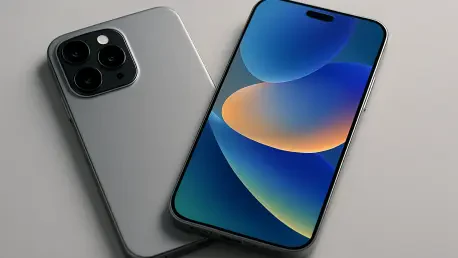Imagine a world where smartphones are not just tools but extensions of personal style and cutting-edge capability, pushing boundaries with every release. Apple’s annual hardware event, held this September, has once again captured global attention with the unveiling of the iPhone 17 lineup. This event, a hallmark of technological anticipation, showcases how Apple continues to redefine the smartphone landscape amid fierce competition. The stakes are high as consumers and industry experts alike look for advancements that justify the hype and price tags in an era of rapid innovation.
This review dives deep into the iPhone 17 series, exploring whether these devices deliver on the promise of groundbreaking design and functionality. With rumors swirling for months about slimmer profiles and enhanced features, the spotlight is on how Apple balances aesthetics with performance. Beyond the iPhones, updates to the Apple Watch and AirPods also signal broader shifts in the tech giant’s ecosystem, making this a pivotal moment to assess their market impact.
In-Depth Analysis of the iPhone 17 Models
iPhone 17 Standard – Elevated Basics
The iPhone 17 standard model emerges as a compelling upgrade, bridging the gap between entry-level and premium offerings. With a slightly larger 6.3-inch screen, it offers a more immersive viewing experience compared to its predecessors. The most notable leap is the shift to a 120Hz display, ensuring smoother scrolling and animations that rival higher-end devices, a feature long awaited by fans of fluid visuals.
Beyond the screen, the standard model introduces a 24-megapixel front camera, a significant boost for selfie enthusiasts and video callers seeking sharper images. New color options, including vibrant purple and green, add a fresh aesthetic appeal to the lineup. Priced at an estimated $800, this model positions itself as a competitive choice for those wanting advanced features without the Pro price tag, though it remains to be seen if the cost aligns with consumer expectations.
iPhone 17 Pro and Pro Max – Redefining Premium
Turning to the Pro tier, the iPhone 17 Pro and Pro Max bring bold design shifts that catch the eye. The Pro model sports a unique rear camera layout with three lenses arranged in a horizontal rectangular bar, integrating repositioned flash and sensor components for a distinct look. A rumored switch to aluminum from titanium for the screen band aims to reduce both weight and production costs, a pragmatic move that could broaden accessibility.
The Pro Max, meanwhile, opts for a thicker body to accommodate a larger battery, addressing long-standing demands for extended usage time. Both models streamline storage options to 256GB, 512GB, and 1TB, eliminating smaller capacities to focus on higher-end configurations. With pricing pegged at around $1,050 for the Pro and $1,250 for the Pro Max, these devices target users who prioritize top-tier specs, though the material change raises questions about perceived value in the luxury segment.
iPhone Air – The Pinnacle of Slim Design
Perhaps the most talked-about addition is the iPhone Air, replacing the Plus model with a groundbreaking 5.5mm profile, making it the thinnest iPhone ever crafted. Boasting a 6.6-inch screen, it delivers a spacious display in an ultra-sleek form factor that outshines competitors in the race for minimalist design. Available in black, silver, and light gold, its aesthetic allure is undeniable for style-conscious buyers.
However, this slender build comes with trade-offs. The iPhone Air is rumored to feature only a single rear camera, a downgrade from dual setups on comparable models, potentially limiting photography versatility. Audio capabilities may also suffer, with speculation of no bottom speaker, relying solely on the top earpiece. Priced at an estimated $950, it sits in a curious middle ground, appealing to design purists while possibly alienating users who value comprehensive features.
Complementary Updates: Apple Watch and AirPods
Apple Watch Lineup – Health and Connectivity Focus
Alongside the iPhone reveal, the Apple Watch lineup received significant attention with updates across its range. The Ultra 3 stands out with faster charging, 5G support, and satellite connectivity, catering to adventurers and tech-savvy users needing robust performance. Rumored health features like blood pressure monitoring and sleep apnea detection promise to elevate its utility, though delays in these rollouts could temper enthusiasm.
The Series 11 and SE 3 also see refinements, with the former potentially mirroring the Ultra’s health advancements at a more accessible price point of around $400. The SE 3, priced near $250, maintains its budget-friendly status with minor tweaks like a larger display. These updates reflect a clear intent to dominate the wearable market by blending innovation with varied price tiers, though the execution of advanced features remains a critical watchpoint.
AirPods Pro 3 – Audio Evolution
Rounding out the hardware refresh, the AirPods Pro 3 bring subtle yet impactful improvements to Apple’s audio portfolio. A sleeker design paired with touch-sensitive controls enhances user interaction, while smaller earbuds and a slimmer case prioritize comfort and portability. The integration of the ### chip boosts active noise cancellation and adaptive audio, aiming to solidify Apple’s edge in premium sound quality.
These enhancements suggest a focus on refining user experience rather than overhauling the product category. While specific pricing remains undisclosed, the emphasis on design and performance indicates a continuation of Apple’s strategy to offer high-end audio solutions. How these changes resonate with audiophiles and casual listeners alike will be key to gauging their market success.
Market Context and Competitive Edge
Industry Trends and Strategic Moves
The iPhone 17 lineup and accompanying devices align closely with current industry trends emphasizing thinner designs and advanced health monitoring. The push for a slimmer profile, epitomized by the iPhone Air, mirrors efforts by rivals like Samsung and Huawei to prioritize portability without sacrificing screen real estate. Apple’s strategic use of materials like aluminum in the Pro models and streamlined storage options reflects a balance of innovation with cost management, aiming to attract a wider audience.
This hardware refresh also underscores a growing focus on wearable tech as a lifestyle companion, with Apple Watch updates targeting health-conscious consumers. By integrating cutting-edge connectivity and potential medical-grade features, Apple positions itself as a leader in this space. Yet, the challenge lies in delivering these ambitious promises without delays, as competitors rapidly advance their own wearable offerings.
Consumer Reception and Rivalries
Consumer reception to these updates will likely hinge on how well Apple addresses the balance between premium features and affordability. The iPhone Air’s design innovations may captivate trendsetters, but compromises like reduced camera capabilities could deter photography enthusiasts. Similarly, pricing across the board, while competitive, must justify the perceived value, especially in markets where economic pressures influence purchasing decisions.
Against rivals, Apple’s ecosystem integration remains a strong differentiator, seamlessly connecting iPhones, Watches, and AirPods for a cohesive user experience. However, with Samsung pushing foldable designs and Huawei advancing in camera tech, Apple must ensure its incremental upgrades and bold experiments like the iPhone Air maintain a competitive edge. The coming months will reveal whether this lineup solidifies Apple’s dominance or opens doors for challengers.
Addressing Potential Hurdles
Design Compromises and Feature Gaps
While the iPhone 17 lineup impresses with its forward-thinking design, certain compromises raise concerns. The iPhone Air’s single rear camera and potential audio limitations due to its ultra-thin build may not meet the expectations of users accustomed to multifaceted functionality. Such trade-offs, while necessary for achieving a record-breaking slim profile, could limit its appeal to a niche audience rather than the broader market.
Additionally, the standard and Pro models, though packed with upgrades, face scrutiny over material choices. The shift to aluminum in the Pro, while cost-effective, might be perceived as a step down from titanium’s premium feel, potentially affecting brand perception among luxury buyers. Apple will need to navigate these design decisions carefully to avoid alienating loyal customers seeking consistent quality.
Uncertainties in Health Tech Rollouts
The Apple Watch updates, particularly the Ultra 3 and Series 11, carry immense potential with rumored health features like blood pressure monitoring. However, delays in implementing these capabilities could dampen excitement, as consumers increasingly expect immediate access to promised innovations. The uncertainty surrounding updated blood oxygen features adds another layer of complexity to Apple’s wearable strategy.
These challenges highlight a broader issue of managing consumer expectations in a fast-evolving tech landscape. If Apple can address these rollout uncertainties through clear communication or phased updates, it may mitigate disappointment. Otherwise, the gap between hype and delivery could impact trust in the brand’s wearable advancements.
Reflecting on Apple’s Hardware Impact
Looking back, the unveiling of the iPhone 17 lineup, alongside refreshed Apple Watch and AirPods models, marked a significant chapter in Apple’s ongoing quest to redefine technology. Each device brought a mix of anticipated upgrades and unexpected twists, from the ultra-slim iPhone Air to the health-focused Ultra 3, painting a picture of a company striving to innovate across multiple fronts. The event underscored Apple’s knack for blending style with substance, even as certain compromises sparked debate.
Moving forward, Apple faces the task of refining these offerings based on real-world feedback, particularly addressing feature gaps in models like the iPhone Air through software updates or future iterations. For consumers and industry watchers, the next step involves closely monitoring how these devices perform under everyday use, especially in competitive markets. Exploring potential expansions, such as a foldable iPhone rumored for 2026 or beyond, offers a tantalizing glimpse into Apple’s roadmap, urging stakeholders to stay engaged with the evolving ecosystem.









